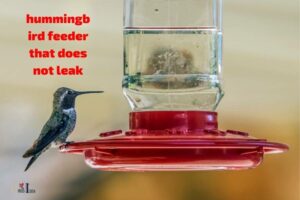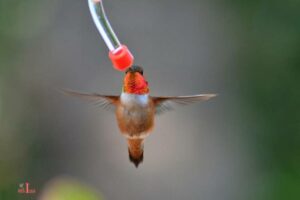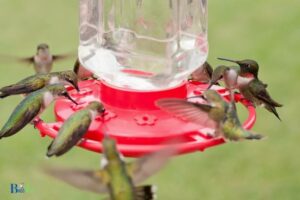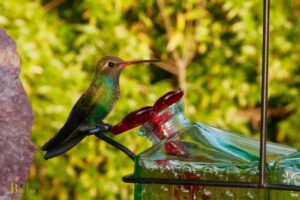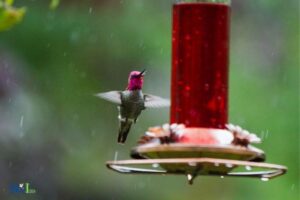When to Put Out Hummingbird Feeders in Maine: May!
The best time to put out hummingbird feeders in Maine is between early May and mid-May.
Hummingbirds typically begin their migration back to the northern regions, like Maine, in early spring. They usually arrive in Maine during the first half of May, depending on weather conditions and available nectar sources.
By putting out hummingbird feeders during early May, you’ll be providing a valuable food source for these tiny birds as they return from their long migration.
To attract and support hummingbirds in Maine, it’s essential to provide them with a consistent food source. Hummingbird feeders should be filled with a homemade nectar solution, consisting of one part sugar and four parts water.
This mimics the natural nectar found in flowers and provides the necessary energy for these fast-flying birds. Be sure to clean and refill the feeders every few days to prevent mold growth and fermentation, which can harm hummingbirds.
Adding native flowering plants to your garden is another excellent way to support and attract these beautiful birds.
12 Months Timeline: To Put Out Hummingbird Feeders in Maine
| Month | Feeder Status |
| January | Not recommended |
| February | Not recommended |
| March | Not recommended |
| April | Start to put out towards end |
| May | Highly recommended |
| June | Highly recommended |
| July | Highly recommended |
| August | Highly recommended |
| September | Highly recommended until mid-month |
| October | Start to remove early in the month |
| November | Not recommended |
| December | Not recommended |
Key Takeaway
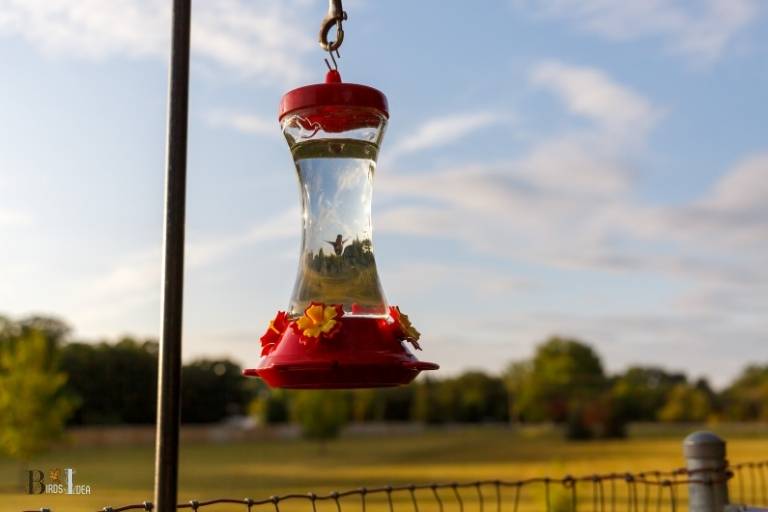
Five Facts About: Put Out Hummingbird Feeders in Maine
Introduction To Hummingbird Feeders In Maine
Maine is widely known as the ‘pine tree state,’ but did you know that it is also home to various species of hummingbirds? If you have recently discovered this fact, you may be wondering when is the best time to put out hummingbird feeders.
Fear not, we have put together a helpful guide to get you started with hummingbird feeders in maine.
Explanation Of The Purpose Of Hummingbirds And Bird Feeders:
- Hummingbirds are essential pollinators, helping with the reproduction of many plant species.
- Hummingbirds have a high metabolism and need to consume half of their weight in nectar every day.
- Bird feeders are a great alternative source of food for hummingbirds, especially when natural sources are scarce.
Brief Mention Of The Types Of Hummingbirds Present In Maine:
- Ruby-throated hummingbirds are the only species of hummingbirds commonly found in maine.
- They are the only species that breed in eastern north america, which includes maine.
- Ruby-throated hummingbirds are easily recognizable for their stunning iridescent green feathers and vibrant red throat feathers in males.
Now that you know the basics about hummingbirds and types of hummingbirds present in maine, you are ready to put out hummingbird feeders. Remember that it is crucial to maintain the feeders with fresh nectar and keep them clean to avoid spreading any diseases.
We hope you find this guide helpful and enjoy observing the beauty of hummingbirds in your backyard.
Importance Of Timing In Putting Out Hummingbird Feeders
The sight of a hummingbird is exciting for bird-enthusiasts and nature lovers. These birds are extraordinary due to their unique appearance and swift movements.
With their vibrant colors and lightning-fast wings, they can capture people’s attention with their beauty and grace.
If you live in maine and want to put out hummingbird feeders, it is essential to understand when you should do so. Let’s look at the importance of timing in putting out hummingbird feeders and how it can impact hummingbird migration patterns.
Discussion Of How Timing Impacts Hummingbird Migration Patterns:
Hummingbirds are known for their migratory behaviors. The timing for putting out hummingbird feeders can have a significant impact on their migration patterns.
It is crucial to set up the feeders in the right season to attract these beautiful creatures.
If you put out the feeder too early or too late, there won’t be any hummingbirds visiting your yard. Thus, it is better to be well informed about their arrival and departure time to enjoy their company.
Importance Of Understanding Maine’S Climate And Temperature Patterns:
It is crucial to understand maine’s climate and temperature patterns before considering when to put out hummingbird feeders. In maine, hummingbirds typically arrive in late april and early may.
These birds thrive in warmer temperature, so it is essential to keep the nectar fresh in the feeder and regularly change it during the summer to avoid fermentation.
In addition to that, it is best to keep hummingbird feeders in the shade, away from direct sunlight, to maintain the nectar’s freshness.
Tips For Putting Out Hummingbird Feeders:
Here are some useful tips to remember when putting out hummingbird feeders:
- Keep the feeder in a shaded area to maintain the nectar’s freshness.
- Keep the feeder clean and regularly change the nectar to prevent fermentation.
- Use a 1: 4 ratio of sugar to water for the nectar mix, and do not use honey.
- Do not add any coloring agents to the nectar.
- Maintain a consistent supply of nectar to attract hummingbirds regularly.
Putting out hummingbird feeders is an excellent way to attract these beautiful birds to your yard. However, timing is everything when it comes to hummingbird migration patterns.
Understanding maine’s climate and temperature patterns is crucial to ensure that you put out the feeder during the right season.
By keeping these points in mind, you can enjoy the company of hummingbirds and marvel at their beauty throughout the summer months.
Climate And Timing Factors To Consider
Overview Of The Seasonal Changes In Maine That Affect Hummingbirds
Maine has a humid continental climate, which means that the state experiences warm summers and cold winters. The seasonal changes in maine have a great influence on the behavior of hummingbirds.
Understanding these changes can help you identify the best time to put out your hummingbird feeders and attract these beautiful birds to your backyard.
Explanation Of When Hummingbirds Arrive In Maine
Hummingbirds are migratory birds that typically spend their winters in central and south america. They begin their journey to maine around late april or early may. It takes them about a month to reach maine, depending on the weather conditions during their migration.
The arrival period for hummingbirds in maine is usually between late april and early june.
Discussion Of The Factors That Influence Hummingbird Migration
Hummingbirds are highly sensitive to changes in weather and daylight length.
The following are some of the essential factors that influence their migration to maine:
- Availability of food: Hummingbirds migrate to places where they can find plenty of food. Their diet consists mainly of nectar from flowers, as well as insects and spiders.
- Temperature: Hummingbirds prefer warmer weather conditions, as flying in cold temperatures can be quite challenging for them.
- Day length: Hummingbirds are known to use day length as a cue for migration. Longer days signify the arrival of spring and the availability of food, which signals them to start their journey to maine.
Tips To Consider When Deciding The Appropriate Time To Put Out Hummingbird Feeders In Maine
Putting out hummingbird feeders is a fun way to attract these beautiful birds to your backyard.
Here are some tips to help you decide the best time to set up your feeders:
- Wait until the last frost has passed: It is essential to wait until the last frost has passed before putting out your hummingbird feeders. Frost can damage the flowers that hummingbirds rely on for food.
- Monitor temperature: Hummingbirds thrive in warmer weather. Therefore, it is vital to set up your feeders when the temperature is consistently above 40°f.
- Consider your location: If you live in northern maine, you may want to wait a few weeks longer before putting out your feeders because hummingbirds arrive later in those areas than in southern maine.
By following these tips and understanding the seasonal changes in maine, you can attract hummingbirds to your backyard and enjoy watching these delightful birds.
Types Of Hummingbird Feeders
When it comes to attracting hummingbirds, setting up a feeder is an excellent way to invite them into your yard.
Maine is no exception when it comes to enjoying these pollinators as it is home to several species, including the ruby-throated hummingbird.
But with so many different types of feeders on the market, it can be challenging to choose the right one. We’ll take a look at the various types of hummingbird feeders, their benefits and drawbacks, and offer instruction on which feeder is best suited for maine’s climate.
Overview Of The Various Types Of Hummingbird Feeders
Here are some of the most common types of hummingbird feeders:
- Glass feeders
- Plastic feeders
- Ceramic feeders
- Window feeders
Benefits And Drawbacks Of Each Type Of Hummingbird Feeder
Before you make a purchase, it’s essential to know the benefits and drawbacks of each type of feeder.
Here’s what to consider:
Glass feeders:
- Benefits: Easy to clean, durable, and uv-resistant
- Drawbacks: Heavy and fragile, difficult to handle
Plastic feeders:
- Benefits: Light-weight, easy to handle, and affordable
- Drawbacks: Prone to fading, can crack
Ceramic feeders:
- Benefits: Durable and aesthetically pleasing
- Drawbacks: Can be heavy, not uv-resistant
Window feeders:
- Benefits: Provide excellent viewing opportunities, easy to install
- Drawbacks: Prone to sun damage, can lead to window strikes
Instruction On How To Choose A Feeder That Is Appropriate For The Maine Climate
When selecting a hummingbird feeder for maine’s climate, here are some tips to keep in mind:
- Choose a feeder with enough capacity to hold at least 16-ounces of nectar.
- Opt for a feeder with bee guards to prevent bees and wasps from accessing the nectar.
- Choose feeders with yellow or red flowers to help attract hummingbirds.
- Select a feeder that is easy to disassemble for cleaning and disinfecting.
By choosing the right feeder, you can safely and successfully attract hummingbirds to your yard in maine. So, whether you opt for a glass, plastic, ceramic, or window feeder, you can enjoy the lively activity of hummingbirds all season long.
Best Practices For Maintaining Hummingbird Feeders
Explanation Of The Importance Of Proper Feeder Maintenance
Hummingbirds rely on nectar as their primary source of food, and hummingbird feeders play a crucial role in providing this nourishment, especially during the migration season.
Maintaining your hummingbird feeder is essential because dirty or contaminated feeders can be detrimental to the birds’ health.
Follow these tips to ensure your hummingbird feeder stays clean and healthy for your feathered friends.
Instruction On How To Clean And Refill The Feeder On A Regular Basis
Regular cleaning and refilling is imperative to ensure the feeder remains clean and free from mold, bacteria, and other contaminants.
Here’s how to do it:
- Start with unplugging the feeder and carefully disassembling all the parts.
- Dump out any remaining nectar and rinse all the parts thoroughly with hot water.
- Use a solution of one part vinegar to four parts water to clean the inside of the feeder and all its components.
- Rinse the feeder with hot water to remove any traces of the vinegar solution.
- Allow the parts to air dry completely before refilling and reassembling the feeder.
- Refill your feeder with fresh nectar, and avoid using any artificial colors or sweeteners.
Discussion Of Other Considerations To Keep In Mind When Maintaining A Hummingbird Feeder In Maine
Apart from regular cleaning and refilling, there are other factors to consider when taking care of your hummingbird feeder in maine.
These include:
- Location: Hummingbird feeders should be placed in areas that are easy for the birds to access and out of direct sunlight. In maine, it’s also important to avoid areas where the feeder could be blown away during windy weather.
- Predators: Keeping your feeder out of reach of squirrels, bears, and other predators is essential. Consider buying a squirrel-proof feeder or hanging it from a high branch.
- Water: Hummingbirds need water to keep their feathers clean and to stay hydrated, so placing a small tray of water near the feeder is a good idea.
- Monitoring: Keep an eye on the feeder to ensure that it’s not running out of nectar, and check regularly to make sure the feeder is still clean and in good condition.
By following these easy-to-implement tricks, you can keep your hummingbird feeder clean and safe, thus ensuring a healthy food source for these delicate and beautiful creatures.
FAQ For When To Put Out Hummingbird Feeders In Maine
When Is The Best Time To Put Out Hummingbird Feeders In Maine?
How Often Should I Change The Nectar In My Hummingbird Feeder?
What Kind Of Nectar Should I Use In My Hummingbird Feeder?
Where Should I Hang My Hummingbird Feeder?
Conclusion
As summer approaches, many people are eager to attract the charming and agile hummingbirds into their yards in maine. To maximize the chances of attracting these tiny birds, it is essential to know the right time to put out hummingbird feeders.
Timing is key as hummingbirds migrate and follow certain patterns of behavior. Based on the insights shared in our blog post, maine residents can put out their hummingbird feeders anywhere from mid-april to early may and keep them up until the first frost.
However, it is crucial to keep a watchful eye on weather patterns and bird activity to make informed decisions about how to best attract hummingbirds.
By following these tips, you can enjoy the company of these fascinating creatures while helping them navigate their long journey ahead.
Remember to keep your feeder clean and filled with fresh nectar, and soon enough, these little marvels will grace your garden with their presence.

